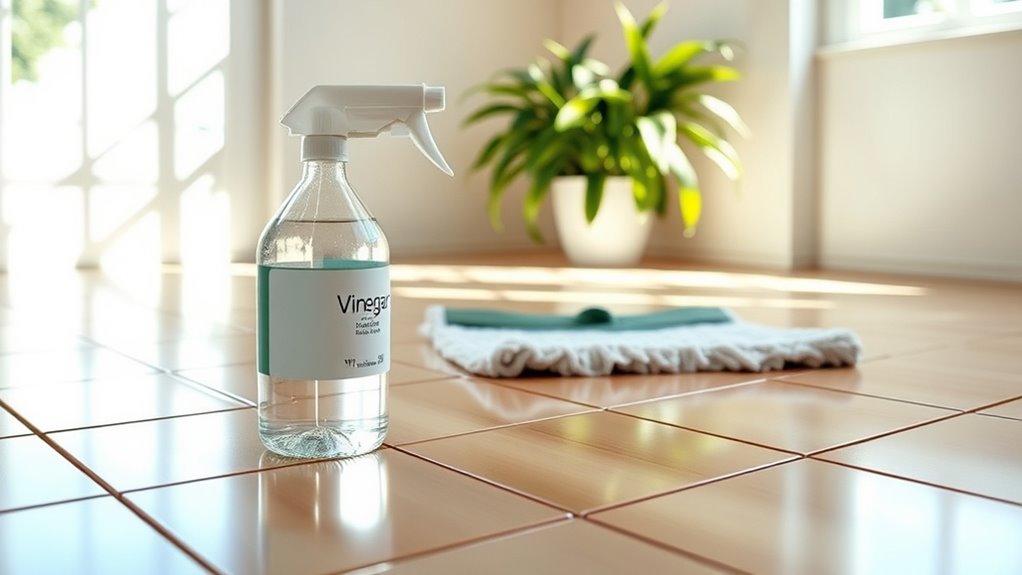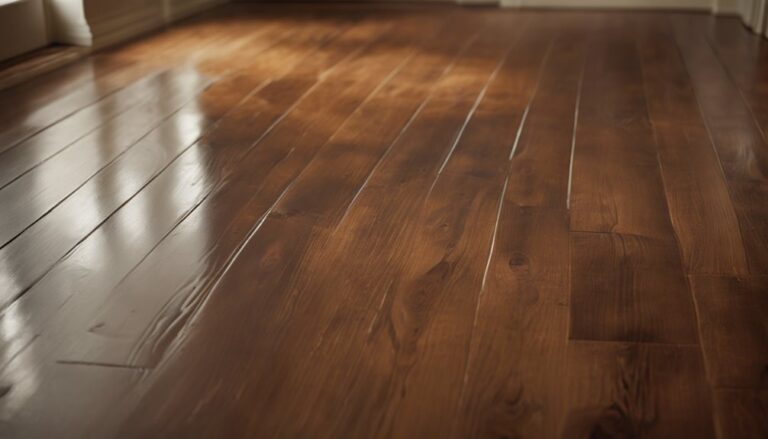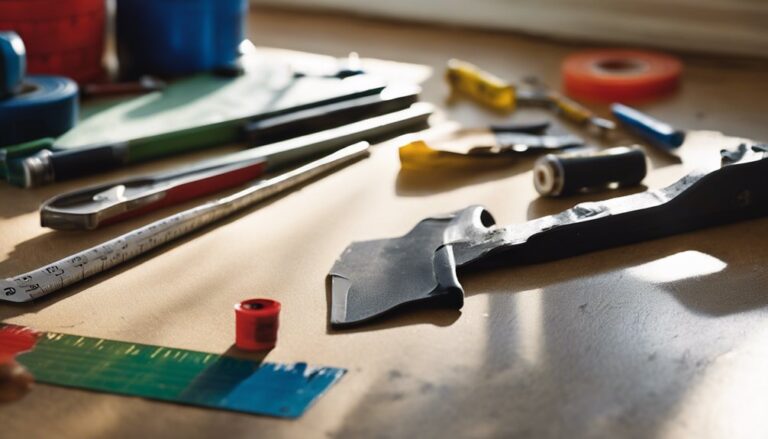To clean tile floors with vinegar, start by sweeping or vacuuming to remove debris. Mix equal parts white vinegar and warm water, then mop using a well-wrung mop to avoid excess moisture. Use smooth strokes and change the solution as it gets dirty. Vinegar works well on ceramic and porcelain tiles but avoid unsealed or natural stone tiles. Always test a small area first to prevent damage. Keep going to discover tips for stubborn stains, drying, and maintenance.
Benefits of Using Vinegar for Tile Cleaning
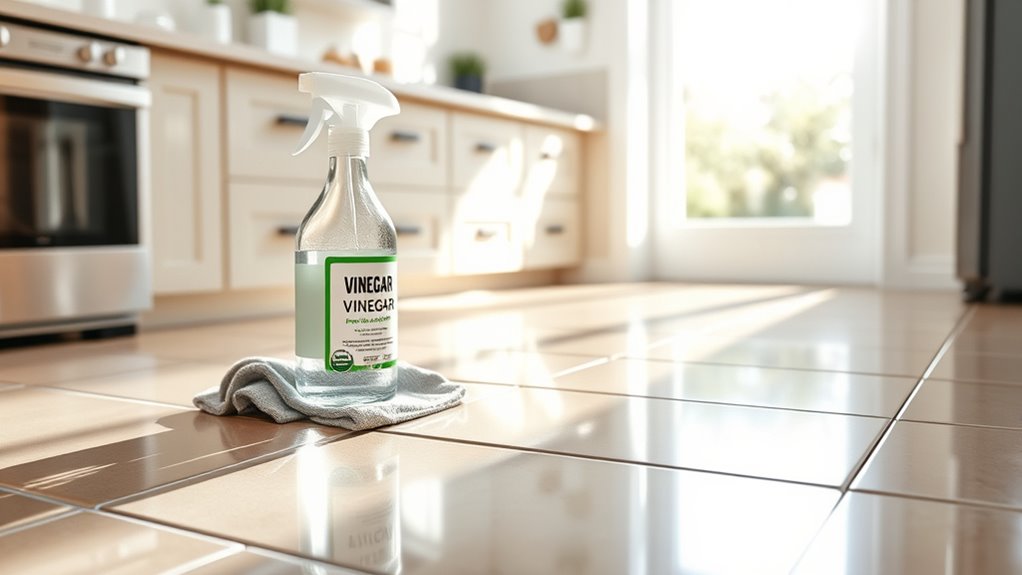
There are several key benefits to using vinegar for tile cleaning that make it a popular choice for homeowners. You’ll appreciate vinegar benefits like its powerful natural acidity, which effectively breaks down grime, soap scum, and mineral deposits without harsh chemicals. It’s an eco friendly cleaning option that reduces your reliance on toxic cleaners, promoting a healthier home environment and minimizing environmental impact. Vinegar’s affordability and accessibility mean you gain freedom from expensive, specialized products. Plus, it’s versatile—you can dilute it to suit different cleaning needs and easily combine it with water to create a safe, effective solution. By choosing vinegar, you’re embracing a sustainable, efficient method that maintains your tile floors’ appearance while supporting your lifestyle of independence and responsibility.
Types of Tiles Suitable for Vinegar Cleaning
You can safely use vinegar to clean porcelain and ceramic tiles without damaging their surfaces. However, avoid vinegar on natural stone tiles like marble or granite, as the acidity can etch and dull their finish. Knowing which tiles respond well to vinegar will help you maintain your floors effectively.
Porcelain and Ceramic
Porcelain and ceramic tiles are among the most durable and water-resistant pavimentazione options, making them ideal candidates for vinegar cleaning. Thanks to advanced glazing techniques, these tiles resist stains and moisture, simplifying tile maintenance. When using vinegar, it effectively breaks down grime without damaging the tile surface, preserving the glaze’s integrity.
| Tipo di piastrella | Durata | Vinegar Suitability |
|---|---|---|
| Porcellana | Molto alto | Safe |
| Ceramica | Alto | Safe |
| Unglazed | Moderare | Use Caution |
| Glazed | Molto alto | Safe |
Just make sure your tiles have a sealed glaze—this protects them from vinegar’s acidity, letting you clean confidently without worry.
Avoid Natural Stone
While vinegar works well on glazed surfaces like porcelain and ceramic, it can cause serious damage to natural stone tiles such as marble, granite, and limestone. These stones are highly sensitive to acidic substances, which can etch their surfaces and dull their finish. If you want to maintain natural stone care properly, avoid vinegar altogether. Instead, opt for alternative cleaners specifically formulated for natural stone. These cleaners preserve the stone’s integrity without compromising its appearance. Using the wrong products restricts your freedom to keep floors looking pristine, so choose wisely. Stick to pH-neutral solutions or those labeled safe for natural stone to prevent costly damage. Protect your investment by tailoring your cleaning routine to the tile type, ensuring long-lasting beauty and durability.
Preparing Your Tile Floor for Cleaning
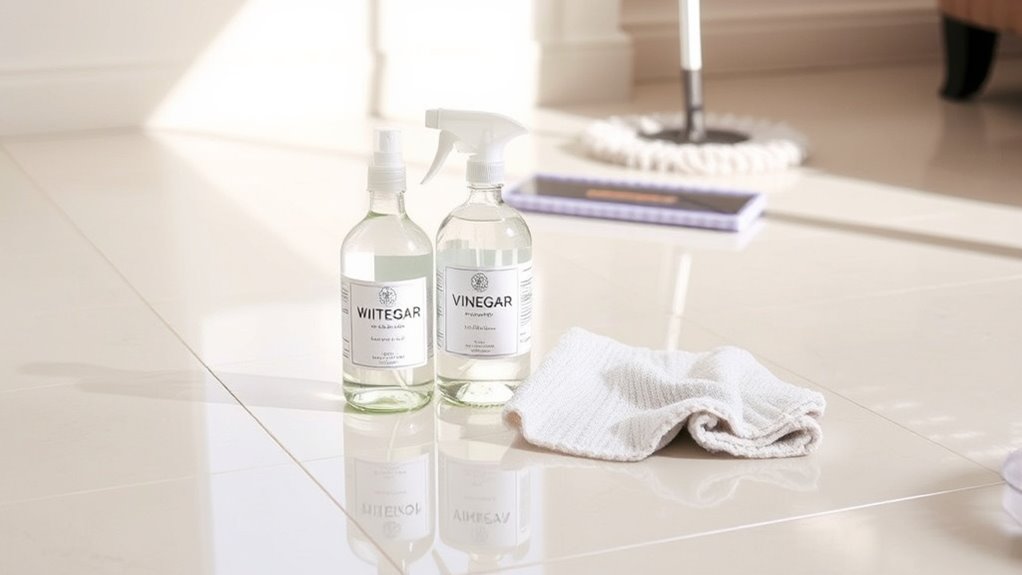
Before you start cleaning, make certain to remove all debris from the floor using a broom or vacuum. Selecting the right cleaning tools, like a soft-bristle brush or mop, is essential to protect your tile’s surface. Proper preparation guarantees an effective and damage-free cleaning process.
Clear Floor Debris
Start by removing all loose debris from your tile floor to assure an effective cleaning process. This critical step in floor maintenance assures dirt and particles don’t scratch or dull the tiles during cleaning. Use a broom or vacuum designed for hard surfaces to thoroughly clear dust, crumbs, and pet hair. Pay close attention to corners and grout lines where debris tends to accumulate. Efficient debris removal not only improves the cleaning outcome but also extends the life of your tile floor. Skipping this step can trap grime beneath your mop, making stains harder to remove. By dedicating time to clear floor debris first, you set the stage for a deeper, more efficient clean, preserving your floor’s appearance and your freedom to enjoy a fresh, vibrant space.
Choose Suitable Cleaning Tools
Removing all debris from your tile floor sets the foundation for effective cleaning, but having the right tools will make the process much smoother and more thorough. Start by selecting high-quality cleaning supplies designed specifically for tile surfaces to avoid damage. Opt for microfiber cloths or soft-bristle brushes to tackle grout lines without scratching. When it comes to floor mops, choose ones with adjustable handles and washable heads for convenience and longevity. A sponge mop works well for gentle cleaning, while a flat mop can efficiently cover large areas. Avoid overly abrasive tools that might wear down the tile finish. By carefully choosing your cleaning supplies and floor mops, you guarantee a deep, effective clean that preserves your tile’s appearance and gives you the freedom to maintain your floors with ease.
How to Make a Vinegar Cleaning Solution
One simple way to create an effective vinegar cleaning solution is by mixing equal parts of white vinegar and warm water. This 1:1 cleaning ratio works well for general tile floor cleaning, balancing acidity and safety. However, depending on the vinegar concentrations—typically 5% acetic acid—you can adjust the ratio. For tougher grime, increase vinegar concentration slightly, but never exceed a 2:1 vinegar-to-water ratio to avoid damaging tile or grout. Always use distilled white vinegar for consistent acidity and avoid scented or colored varieties, which can leave residues. By mastering these cleaning ratios and understanding vinegar concentrations, you maintain control over your solution’s strength, ensuring your tile floors get thorough, effective cleaning without risking damage. This approach gives you freedom to customize your mix confidently.
Step-By-Step Guide to Mopping With Vinegar
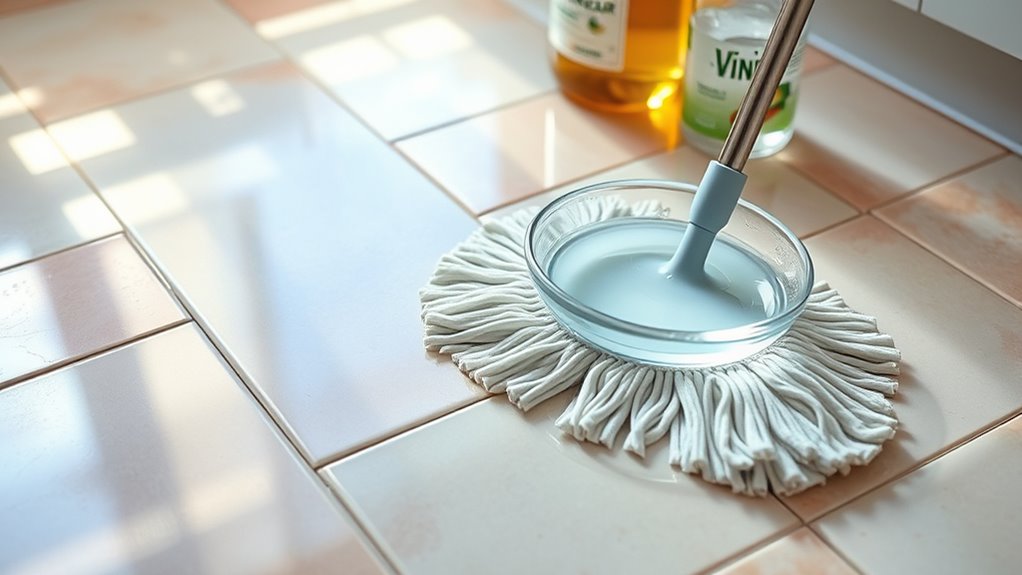
After preparing your vinegar cleaning solution with the proper ratio, it’s time to apply it effectively to your tile floors. Start by sweeping or vacuuming to remove loose dirt. Dip your mop into the solution, wring it out well to avoid excess moisture, which can damage grout. Use smooth, even strokes, following a consistent pattern—usually from one corner toward the exit—to prevent stepping on wet areas. Change the water when it gets dirty to maintain cleaning efficiency. For floor maintenance, avoid harsh scrubbing to protect tile surfaces. Once mopped, allow the floor to air dry or wipe with a clean, dry cloth for a streak-free finish. Mastering these mopping techniques guarantees your tile floors stay spotless and durable without restricting your freedom to enjoy your space.
Removing Stubborn Stains With Vinegar
Tackling stubborn stains on tile floors often requires a stronger approach than regular mopping. For effective stain removal techniques, start by mixing equal parts of white vinegar and water in a spray bottle. Spray the solution directly onto the stain and let it sit for 5 to 10 minutes. Vinegar’s effectiveness comes from its natural acidity, which breaks down tough grime without harsh chemicals. Next, scrub the area gently with a soft brush or sponge, focusing on the stained spots. If the stain persists, apply undiluted vinegar carefully and repeat the process. Rinse the floor with clean water afterward to remove any vinegar residue. By mastering these targeted stain removal techniques, you maintain your tile’s appearance while enjoying the freedom of a natural, cost-effective cleaning method.
Tips for Drying and Polishing Tile Floors
Although cleaning removes dirt and stains, properly drying and polishing your tile floors is crucial to prevent water spots and restore their shine. Mastering effective drying techniques and polishing methods will keep your floors looking pristine.
- Use a microfiber mop or absorbent towel to quickly soak up excess water after cleaning. This prevents streaks and water marks from forming.
- Allow adequate air circulation by opening windows or using fans. This speeds up drying, reducing the chance for residue buildup.
- For polishing, apply a small amount of a tile-safe polish or a mixture of water and a few drops of olive oil. Buff gently with a soft cloth in circular motions to enhance shine without damaging the surface.
Following these steps guarantees your tile floors dry thoroughly and maintain a brilliant, polished finish.
Precautions When Using Vinegar on Tiles
While vinegar is a popular natural cleaner for tile floors, you need to be cautious when using it to avoid damaging the surface. The vinegar concentration plays an essential role; too strong, and it can erode certain tile finishes, especially natural stone or unsealed tiles. Always dilute vinegar with water and test a small area first. Here’s a quick guide:
| Tipo di piastrella | Recommended Vinegar Concentration | Precaution | Suitable for Sealed Finish | Avoid On |
|---|---|---|---|---|
| Ceramica | 1:1 (vinegar:water) | Test first | SÌ | Porous or unsealed |
| Porcellana | 1:2 | Avoid prolonged exposure | SÌ | Pietra naturale |
| Pietra naturale | Not recommended | Use alternate cleaner | No | High vinegar conc. |
| Vinile | 1:3 | Risciacquare abbondantemente | SÌ | Strong acid cleaners |
| Unsealed Tiles | Not recommended | Can etch surface | No | Vinegar solutions |
Use vinegar wisely to protect your tile finish and maintain freedom in your cleaning choices.
Natural Alternatives to Vinegar for Tile Cleaning
If you’re hesitant to use vinegar on your tile floors due to its acidity, there are several natural alternatives that can effectively clean without risking damage. Here are three reliable options:
- Baking Soda Alternative: Mix baking soda with water to form a paste. It gently scrubs away grime and neutralizes odors without harming tile surfaces.
- Lemon Juice Solution: Combine lemon juice with water for a natural disinfectant. Its mild acidity breaks down stains and leaves a fresh scent.
- Castile Soap Mix: Dilute liquid Castile soap in warm water. This biodegradable soap cleans effectively while being gentle on tiles.
Each choice provides a safe, eco-friendly way to maintain your floors, giving you freedom from harsh chemicals while keeping your tiles spotless.

